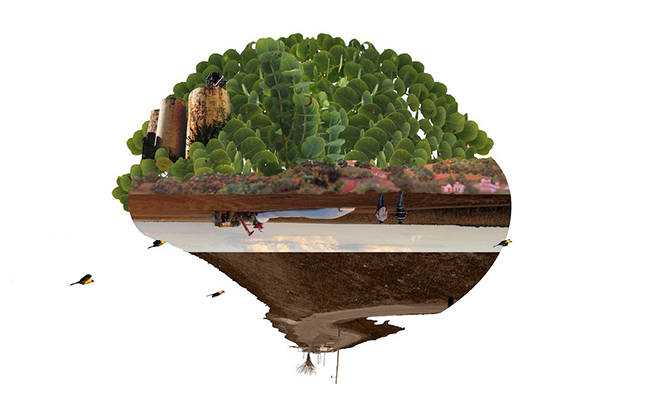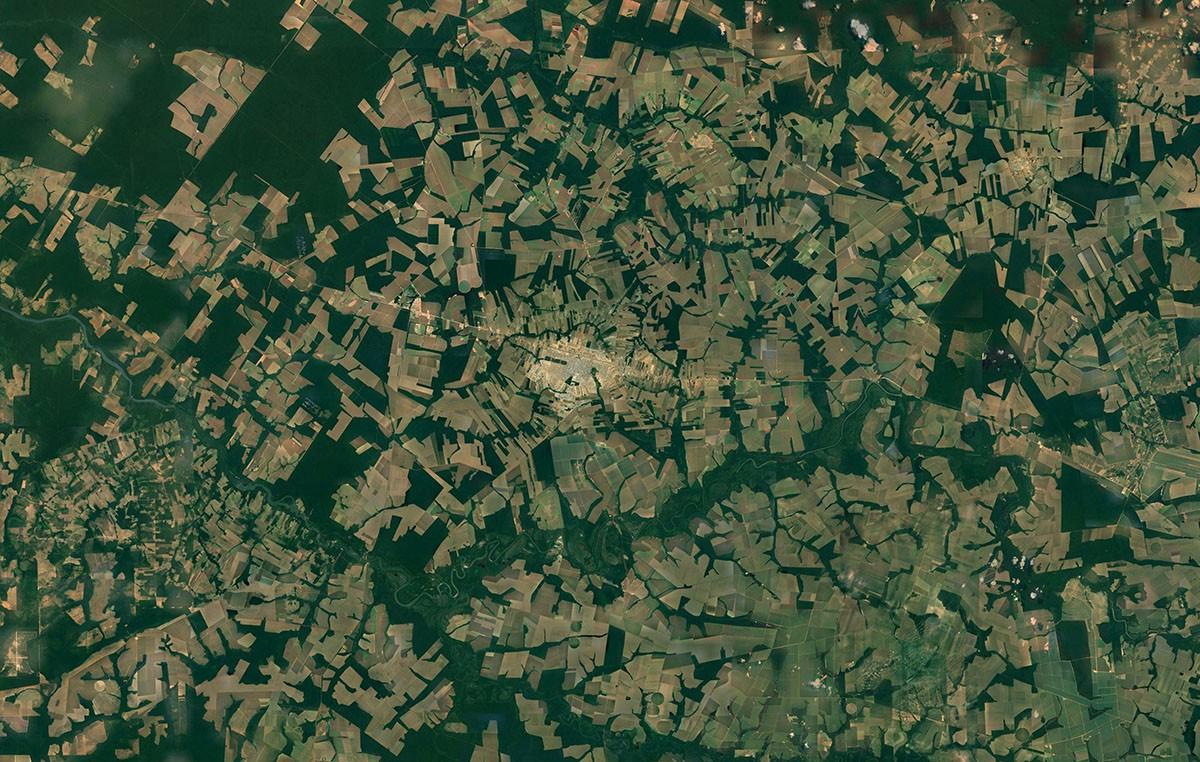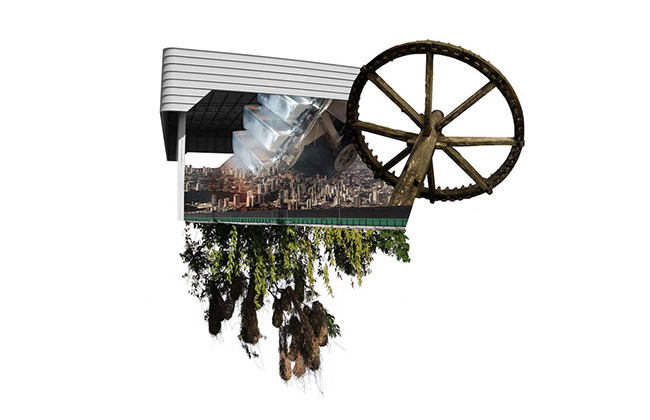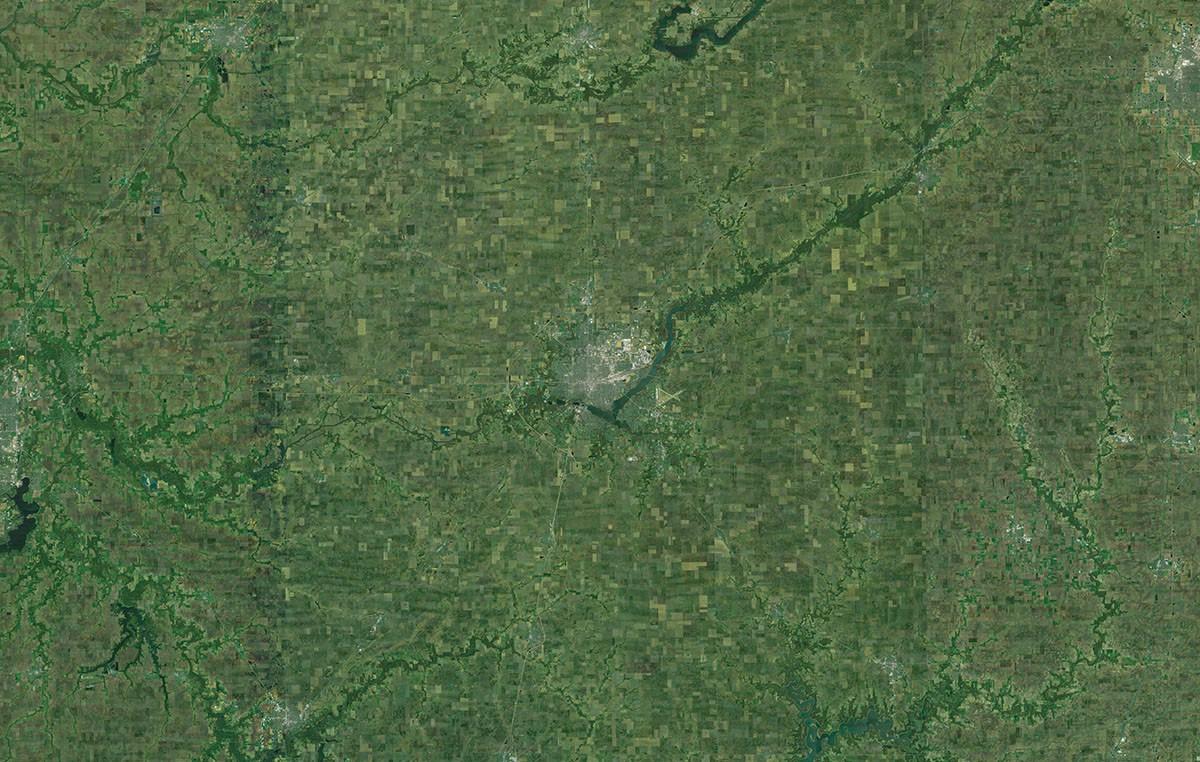Ryan Griffis

If you drive through the flat territories of Illinois, Indiana, or Iowa — US states that form the center of a region known as the “corn belt” — you are almost certainly going to be surrounded by vast rows of corn and soybeans for much of the time. On the ground, stalks of corn create eight-foot-tall corridors along state and county roads from mid-summer through the fall. Throughout the summer, the much shorter, and leafy, soybean plants resemble a vast, green shag carpet that extends to the horizon. From the vantage point of a plane approaching a regional airport, the rectangular fields of these two plants form a monochromatic patchwork of greens, yellows and browns that change with the seasons. Without knowing much about these crops, it’s possible to imagine yourself in a bucolic territory of agrarian splendor; a Grant Wood painting come to life. As you drive through endless corn corridors and soy carpets, you might be awed by their horizontal reach and scale — an endless expanse of a single substance, like the ocean. Considering the sheer energy and power needed to plant and harvest these fields, year after year, you might experience something like the sublime. But, with more historical and material knowledge, standing on the edge of a field planted with corn or soy can resemble the experience of standing on the edge of an open-pit mine. This story begins by leaping from the edge of the mine, into the pit.
I. Where There’s Loading, There’s Unloading
It’s loud and dusty. The dust is heavy and oily and it sticks to everything: the machines, the ground, our clothing, the lenses of our cameras. The head engineer is telling us how things work, but it’s hard to hear, and harder to concentrate with the simultaneously ear-piercing and gut-rumbling noise emanating from the hulking steel machine operating in front of us. We’re at a grain-loading terminal in the town of Belle Chasse on the Mississippi River in Louisiana, looking at a “continuous barge unloader” that is made by Heyl Patterson, a Pittsburgh-based manufacturer of heavy machinery. This imposing device consists of a series of large buckets running in a loop, designed to scoop up dry bulk commodities from loaded barges. Each bucket can hold about 1,500 pounds of corn or soy, enabling the machine to move four million pounds per hour. As we’re watching, it’s unloading soy from river barges originating in the Upper Midwest. Once unloaded and graded for quality, this soy will fill a waiting Panamax ship bound for China, where most of it will be used as animal feed.[1] China, where soybeans were originally cultivated from wild varieties in the highlands thousands of years ago, is now the largest importer of soy, bringing in over 92 million tons in 2016/2017, mostly from the US and Brazil.[2] Soy farms currently occupy 120 million hectares around the world, and have been increasing by more than 5% each year.

II. Harvesting Space
The harvesters seemed to hover above the ground amidst an endless expanse of cleared land. As the sun set behind them, they looked like unmanned vehicles designed to traverse Mars, piloted remotely by some distant operator. Our hosts invited us to climb into the cabins as they completed the day’s harvest. We rode back and forth, in 100-meter laps, listening to classic rock and stopping only to unload the mechanically separated corn into large trucks waiting nearby. In the last hours, the only things visible were the glowing controls of the cabin and several feet of cornrows illuminated by the advancing combines’ headlights. It was a pleasant evening in June and we were somewhere near the town of Sinop in the North of the agricultural “frontier” state of Mato Grosso in western Brazil. The scene could have been mistaken for Central Illinois, sometime in late fall. We were on a fazenda, or plantation, that would dwarf most US corn farms. Several months earlier, these workers were riding over this same land, in similar machines, harvesting soy. This harvest was of the second corn crop, known as safrinha, which is planted after the main soybean crop, coming in its turn after an earlier corn crop, for a total of three harvests per year.
Beneath the machines, beneath the dried-on-the-stalk corn, chemical fertilizers and pesticides have been mixed with industrial quantities of lime to turn the well-drained, but acidic, soils into a medium compatible for hosting monoculture commodity crops. Less than forty years ago, this soil was populated by the fire-resistant roots and subterranean trunks of native legumes and shrubs that thrive in the region’s extreme rainy and dry seasons. The Kayabi and Apiaká peoples, colonies of leaf-cutter ants, maned wolves, jaguars, and giant ant-eaters that lived amongst these plants were largely killed or forcibly relocated to preserves, parks and reservations.

Sinop, Mato Grosso, Brazil
Sinop (the name is an acronym: Sociedade Imobiliária Noroeste do Paraná/Northwestern Paraná Real Estate Society) is an agricultural boomtown first colonized in the 1970s in the Rio Tapajos basin, where the grasslands of the Cerrado meet the forests of the Amazon.[3] The Cerrado covers one quarter of Brazil (an area roughly the size of Spain, France, Italy and the UK combined) and is South America’s second largest biome, after the Amazon forest. Known as a neotropical savannah, it consists of both woodlands and grasslands, and is home to at least 2,300 vertebrates and 12,000 native plants, over 30% of which are unique to the region. Scientists have estimated that up to 70% of the biomass of living vegetation in the Cerrado is underground. This diversity, and the fact that more than half of it has been lost to development, has earned it recognition as one of thirty-five global “biodiversity hotspots.”[4] In just one year, 2009–2010, 6,500 km2 of native Cerrado (more than twice the size of Rhode Island) was lost to agricultural development.[5]

III. Running Aground
Standing on a hill in the 3,600-acre Nachusa Grasslands preserve in Northern Illinois, an expanse of tall-grass prairie surrounds me. In the distance, a lone bison crawls across my field of vision, heading toward a pond where its herd is drinking and bathing, taking refuge from the August heat. As it walks, only the top of its head and back are visible above the six-foot-high grasses and flowers, like the surfacing body of a hairy, horned whale coming up for air. Seeing this, it wasn’t difficult to imagine the disorienting experience of European settlers as they traversed hundreds of miles of these grasslands, imagining themselves in the middle of an inland sea.
Today, less than 0.01% of what was once a vast, 22 million acre tall-grass prairie remains in the State of Illinois. If the grasslands of the Midwest could once have been thought of as a sea, teeming with unknown life and hidden dangers, that sea has been drained and replaced with a homogenous, chemical-fueled landscape of commodity corn and soy. The amount of land occupied by these industrial crops in the US averages more than 170 million acres annually, an area roughly the size of Texas. Grasslands and savannahs constitute up to 40% of the Earth’s terrestrial surface, and 70% of the world’s agricultural areas. They also contain 20% of the world’s soil carbon stocks.[6] Colonial and industrial cosmologies have imagined grasslands as empty spaces waiting to fulfill their potential as a source of wealth and controlled productivity. In the process, vast amounts of biological and cultural diversity are sacrificed, and gigatons of carbon are released from the soil into the atmosphere.

Decatur, Illinois, USA
IV. Feeding the Future, Without Food
It is believed that maize, or corn, was first cultivated by peoples in the Central Balsas River Valley in southern Mexico about 9,000 years ago. Over hundreds or thousands of years, a wild grass known as teosinte was selectively bred, creating varieties of maize.[7] According to narratives of the Maya and related cultures, humans were created out of maize dough, after unsuccessful attempts using mud and wood. Today, more than 1 trillion metric tons of corn is produced on 177 million hectares of land around the world. In the United States, over 90% of the corn produced is genetically modified to resist insects and tolerate herbicides. Humans do not consume the vast majority of the world’s corn directly, no more than they do soybeans. Instead, it is predominantly used to feed chickens, hogs and cows in confined facilities.
One destination for the unfathomable amounts of corn grown in the US sits just outside Chicago: a processing plant operated by Ingredion (formerly known as Corn Products International). Founded in 1906 as National Starch, this company patented the process for making pure dextrose in the 1920s, and in 1967 began making high-fructose corn syrup. Today, Ingredion is emblematic of an industry built on what architectural historian Sigfried Giedion referred to as the “artificial dissipation” of a coordinated “surplus production” of corn.[8] The company’s products don’t meet a direct demand for food and nutrition; they modify qualities like “mouth feel” in foods like ice cream.
Why are such vast amounts of land dedicated to growing things that are, for the most part, inedible? Meat is one obvious answer, as chickens, hogs, and cows consume most of the soy and corn grown in the US and Brazil, and global meat consumption increases at a rapid pace. Did the demand for meat precede the glut of corn and soy, or was the increase in animal slaughter facilitated by an already existing surplus of these crops?
I meet with several experts, of various kinds, to try to understand this peculiar use of land that we call the grain trade, and why it exists. Economists tell me to look at markets, prices, and demands for products. Engineers explain problems of efficiency and predictability, and the need to develop solutions to problems like post-harvest loss. Agronomists describe the need to develop seed varieties that can thrive in inhospitable soil types and climates. One shared aspect of all their stories is the primary role that soy and corn play as protagonists in the struggle to “feed the future.” This narrative is more than a little misleading, however, as geographer Gustavo Oliveira tells me. He explains that soy is so highly valued by industry because of the “co-products” that result from the crushing process. Each crushed soybean results in 79 percent meal (98 percent of which goes to feed chickens, hogs, and cattle), 18.5 percent oil and 2.5 percent waste or hulls. It’s not the need for more nutrition that is driving the expansion of soy, Oliveira argues, it’s the increasingly meat-heavy diet of a growing population, and even more importantly, it’s the ability for corporate and state actors to use soy’s “flexibility” for industrial and financial advantage. The consequences of this are significant:
The unfolding dynamics of flex crops and commodities is an expression of the appropriation and substitution of biological crops for industrial processes that can render both raw materials and products more fungible in the interest of capital accumulation. This contradictory process whereby a multiplication of uses of a single monoculture also reduces the diversity of agro-ecosystems, diets, and even cultural practices, ultimately increases our collective vulnerability to catastrophic pest outbreaks, price shocks and market volatility, food crises, and the ensuing social upheavals and rush for land, water, and other natural resources.[9]
V. Cultivating Grasslands
Organic farmers, prairie conservationists and indigenous activists in the US Midwest, along with biologists and peasant farmer organizers in Brazil’s Cerrado, tell me more stories set in a different world. The tallgrass prairies of the US Midwest are all but gone, and it hardly seems sufficient to recreate patches of them as living dioramas of non-human nature. Bill Quackenbush, Tribal Historic Preservation Officer for the Ho-Chunk Nation, tells visitors to the Kickapoo Valley Reserve that the tallgrass prairie there is not idle land, left to a “natural state.” Instead, it is a form of agriculture, a cultural space, co-created by human and non-human inhabitants. Quackenbush explains that the plants there tell both their own stories and narrate the stories of their human co-inhabitants through their importance as food, medicine, and markers of place. The Ho-Chunk Nation, in 2016, amended their tribal constitution to include the protection of the Rights of Nature within their territory, recognizing that “ecosystems and natural communities… possess an inherent, fundamental, and inalienable right to exist and thrive.”[10] Industrialized agriculture and the various forms of urban and rural lifeways that accompany it have quickly reduced the systems of life that have co-evolved over centuries in a place like a grassland. It represents an unmaking of an ecosystem that was/is simultaneously cultural and biological.
At the beginning of this story, I proposed that the agricultural landscape of the US corn belt could be viewed as an open pit mine, not unlike those where mineral resources, such as copper or iron, are extracted from the Earth. If we were to, metaphorically and materially, descend into the open expanse of a corn or soy mine, what, exactly, would we see in the sedimentary layers surrounding us? The depth of a soy mine may seem rather shallow, but its apparent lack of depth is deceiving. In the meters of topsoil lost to the plow and the networks of drainage canals are the stories of communities of bison, plants, human societies, and fire. These lost stories belong to human and non-human authors, as do the destructive stories that explain the US corn belt and Brazil’s Soy Frontier. These stories are rehearsed and challenged by the descendants of colonists, forced migrants (what Kamau Brathwaite and Jodi Byrd describe as arrivants), and indigenous lifeways, written in the sediment lining the walls of the mines.[11] If colonial and capitalist energies could so completely drain prairies and wetlands, and replace them with endless acres of monoculture crops in little more than one hundred years, then maybe in a similar period of time, we — the current authors and readers of these stories, together — can climb out of the pit and learn to live with more complex ecosystems.
All images by and courtesy the artist. A Great Green Desert: Into the Pit, 2018, digital photomontage from original photographs.
[1] Domestically, 98% of US soy meal is used as feed for hogs, chickens and cows. The rest ends up as oils, biofuels, chemicals, and a very small amount as food for human consumption. See the Wisconsin Soybean Association’s “U.S. and Wisconsin Soybean Facts,” http://www.wisoybean.org/news/soybean_facts.php (accessed January 6, 2017) and Gustavo de L.T. Oliveira and Mindi Schneider, “The Politics of Flexing Soybeans in China and Brazil,” Think Piece Series on Flex Crops & Commodities, №3, September 2014, Transnational Institute, Amsterdam, p. 2.
[2] “Oilseeds: World Markets and Trade,” USDA Foreign Agricultural Service, October 2017.
[3] Sue Branford and Maurício Torres, “Battle for the Amazon: As Sinop grew, the Amazon rainforest faded away,” Mongabay, February 1, 2017. https://news.mongabay.com/2017/02/battle-for-the-amazon-as-sinop-grew-the-amazon-rainforest-faded-away/ (accessed January 9, 2018).
[4] “Ecosystem Profile: Cerrado Biodiversity Hotspot,” Critical Ecosystem Partnership Fund, April 2016. Carlos A. Klink and Ricardo B. Machado, “Conservation of the Brazilian Cerrado,” Conservation Biology, vol. 19, no. 3, June 2005, pp. 707–713.
[5] “Production and Exportation of Brazilian Soy and the Cerrado: 2001–2010,” World Wildlife Fund, Brasilia (DF), June 2012, p. 5.
[6] Challenges and opportunities for carbon sequestration in grassland systems: A technical report on grassland management and climate change mitigation, Compiled by Richard T. Conant for the Food and Agriculture Organization of the United Nations (Rome: 2010). http://www.fao.org/fileadmin/templates/agphome/documents/climate/AGPC_grassland_webversion_19.pdf (accessed November 7, 2017).
[7] Carroll, Sean B., “Tracking the Ancestry of Corn Back 9,000 Years,” The New York Times, May 24, 2010, p. D2.
[8] Giedion, Siegfried, Mechanization Takes Command: A Contribution to Anonymous History, Oxford University Press, (New York), 1948.
[9] Gustavo de L.T. Oliveira and Mindi Schneider, “The Politics of Flexing Soybeans in China and Brazil,” Think Piece Series on Flex Crops & Commodities, №3, September 2014, Transnational Institute, Amsterdam, p. 15.
[10] “Ho-Chunk Nation General Council Approves Rights of Nature Constitutional Amendment,” Press Release from the Community Environmental Legal Defense Fund, September 18, 2016. https://celdf.org/2016/09/press-release-ho-chunk-nation-general-council-approves-rights-nature-constitutional-amendment/ (Accessed February 15, 2018).
[11] Barbadian poet/scholar Kamau Brathwaite and Chickasaw scholar Jodi Byrd (in The Transit of Empire: Indigenous Critiques of Colonialism. Minneapolis: University of Minnesota Press, 2011) use the term arrivant to differentiate subjectivities forcibly brought into settler-colonial societies, including enslaved Africans in the Americas.
Ryan Griffis is an artist currently teaching in the School of Art + Design at the University of Illinois at Urbana-Champaign. Under the name Temporary Travel Office, Ryan has created work and publications that attempt to use tourism as an opportunity for critical public encounters. The Temporary Travel Office has created work for venues such as the MAK Center for Art and Architecture, Los Angeles Contemporary Exhibitions, SPACES Gallery, Los Angeles County Museum of Art, Links Hall, PS122, LA Freewaves, and the Finger Lakes Environmental Film Festival. His writing has appeared in international print and online journals and in the edited volumes Cities and Inequalities (Routledge, 2015) and Support Networks (Chicago Social Practice History Series, SAIC/University of Chicago Press, 2014). His recent work employs the form of documentary images and writing to address regional political ecologies and extractive agriculture.